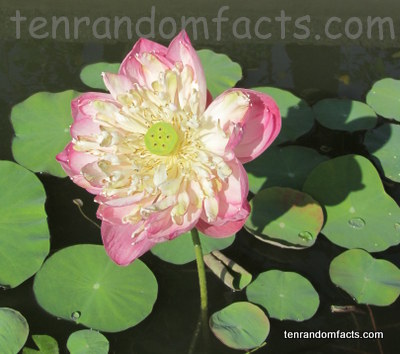The sacred lotus will spice up your aquatic garden.
- Sacred lotuses are an aquatic species of perennial plant, native mostly to tropical and warm temperate climates of Asia and north to north-eastern Australia, and while they have a similar appearance to water lilies, they are unrelated.
- The ‘sacred lotus’ is also known simply as ‘lotus’, as well as ‘sacred water lotus’, ‘Indian lotus’, ‘sacred water lily’, ‘rose of India’, ‘lotus lily’, ‘pink lotus lily’, ‘pink water lily’, and ‘bean of India’.
- The scientific name of the sacred lotus is Nelumbo nucifera and it is from the family Nelumbonaceae, the family of lotuses, and it is one of two living species in the family.
- The sausage-like tubers of sacred lotuses grow from seeds deposited at the muddy bottom of bodies of water, and they grow stems of leaves, 1 to 2.5 metres (3.3 to 8.2 feet) in height to reach the surface of the water, and the diameter of the leaves ranges from 20 to 70 centimetres (8 to 27.6 inches).
- The flower head of the sacred lotus sits above the water and is 15 to 25 centimetres (6 to 10 inches) in diameter, and can be coloured pink, to white sometimes with a reddish tint, and they have a sweet scent.
- Seeds of sacred lotuses grow in a receptacle that is originally the centre of the flower head, while the head turns downwards as the seeds mature; and seeds of ancient specimens have been known to be still usable centuries later, while one seed, estimated to be almost 1300 years old at the time, was germinated in 1994.
- Sacred lotuses are considered symbolic in a number of religions including Buddhism and Hinduism, and are said to represent creation, purity, incarnation, and beauty, among other things.
- Much of the sacred lotus plant, including the flowers, is edible, with the tubers being able to be used like a vegetable by boiling, frying, baking, and steaming them; while the seeds and leaves can be eaten both raw and cooked; and the leaves can also be used as a food wrapper.
- The sacred lotus is a fundamental plant in traditional Asian medicine with all parts of the plant being utilised; and a wide variety of illnesses are treated with the plant, including nausea, fever, diarrhoea, and mushroom poisoning.
- The temperature of sacred lotus flowers will remain at a constant 30°C to 35°C (86°F to 95°F), even despite changes in the temperature around them; while the leaves are extremely water repellent and as such are self-cleaning, with this phenomena being described as the ‘lotus effect’.





